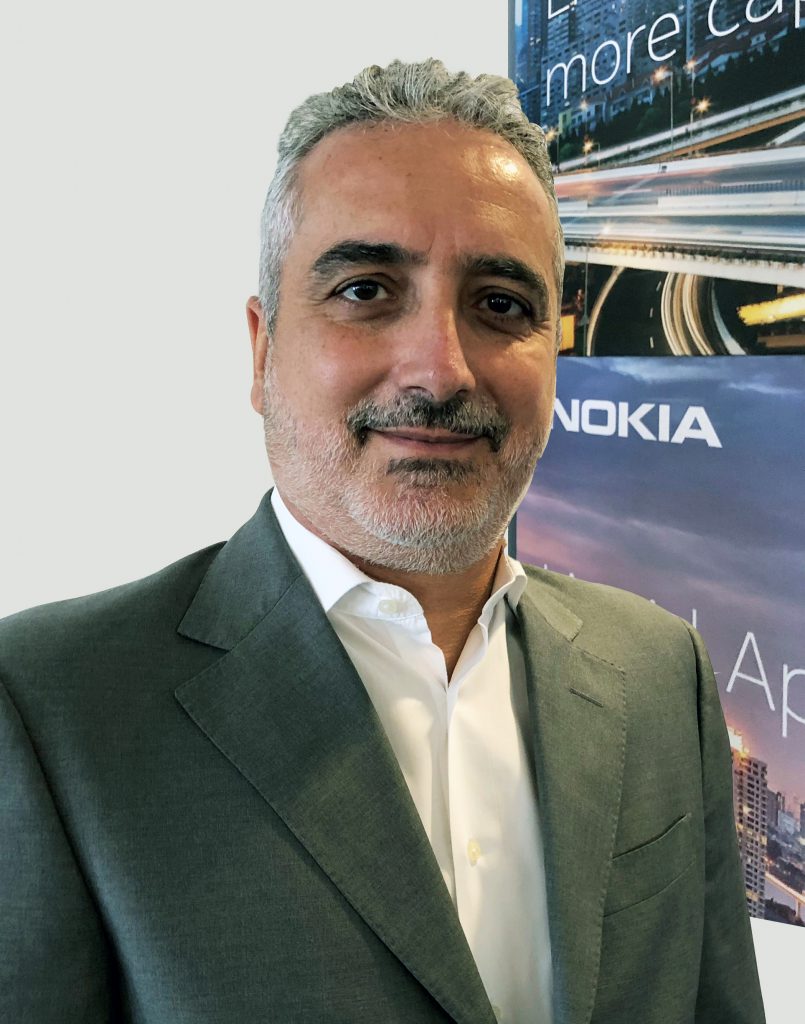With Digital Transformation full of promise for enterprises, Henrique Vale, Head of Nokia Software for MEA at Nokia, tells us how businesses can best use the process to make themselves more competitive.
In what ways can Digital Transformation make enterprises more competitive?
In the digital world, everything must be immediate, intelligent and intuitive. But advances in technology don’t necessarily mean faster, smarter and better. Today, time is still in short supply and productivity growth is stuck in the slow lane.
By intelligently connecting humans, machines and data, enterprises can boost productivity. They can bring new services to market faster, ideally acting on the moment, to enrich and monetise customer experience, while operating ultra-efficiently.
With the right architecture and automated network operations and analytics, enterprises can achieve even more. Enabling machines and humans to do what they each do best creates time for what matters most. These days life happens in digital time.
How can Nokia help enterprises begin their Digital Transformation journey?
We know that Digital Transformation promises a lot. Most of the companies in our industry are in the process of some sort of Digital Transformation. According to a study made by Forbes, on a global basis, enterprises are expected to spend about $1.3 Trillion on Digital Transformation.
However, the sad truth is that 70% of their projects fail. This is an expensive proposition! With 70% of them falling short of their stated goals, that is a $900 billion miss. One can say that this is a massive mismanagement. This is the time when we collectively must take a step back and look at what we are doing and find a way to increase our success rate.
For that we should look at the 30% of the projects that succeed. What do they have in common? They move in digital time, with a corporate wide approach to digitalisation, without fear of disruption. They are bold. They also have a thoughtful approach to digitisation. For that reason, we should not talk about Digital Transformation but rather Digital Reinvention.
This involves getting rid of the notion of transformation entirely. Digital leaders don’t transform slowly. They reinvent quickly. They do it by:
- Setting a clear digital ambition
- Having a clear e2e design point
- Launching smart pilot projects that go beyond providing new technology and rather aim at exploring new ways of working. Such pilots are important as they provide the opportunity to either succeed or quickly fail
- Then scaling successful projects with the newly created knowledge from the pilot
- De-risking through the proper investments in change, resources, models and technology is the final step. Many companies fail here – especially in the human factor of change management.
At Nokia, we developed a significant experience over the last three years by implementing diverse digital reinvention programmes with many telecom service providers and enterprises around the world. We started with ourselves by completely redesigning a new software assets and solutions portfolio around capturing digital times.

What are the main factors CIOs need to contemplate when considering the Digital Transformation of their organisations?
We’re living in an unprecedented age of opportunity for communication services providers (CSPs). Those that are customer-centric, data-driven and agile will seize the day and break through their legacy barriers.
Faced with declining traditional revenues, CSPs need to increase customer mindshare and share of wallet. Customers are looking for something new, bold and differentiated, but that doesn’t mean CSPs’ focus should be the speed of bringing digital services to market.
Yes, they need to move fast, but speed is not enough; agility is the key. Without agility, speed to market is the same as outdated ideas spun out faster.
Agility and data often go hand in hand. For instance, most CSPs are sitting on a goldmine of data. The approach to data should be more proactive and reactive, creative and innovative. It’s about being data-driven in their decision-making – connecting insights with actions and predictions with personalisation.
And this needs to happen within a fabric that combines the intelligence of technology and people to enhance each other. The totality is what we at Nokia call ‘connected intelligence’.
Today’s reality for many CSPs, however, is quite different. Data isn’t an instant insight until you ‘close the loop’, revalidate and continue that cycle. Technologies and teams are often siloed. Legacy systems and processes are unable to cope. Risks are commonly avoided. Just some of the reasons why many miss out, compared to how digital leaders use data analytics and act with agility.
How can Nokia help service providers and react to the changing needs of their customers?
If the network is poor, customer’s experience is bad. If the operations are slow, the customer will have to wait a long time to get services set up and problems resolved. If the care or billing is off, a customer may decide to find another supplier.
So, all systems within a service provider must come together to create a great experience. The operations engineer needs tools that allow delivering services in digital time. The networks need to feed relevant information to the customer experience layer.
The silos created in departments prevent service providers from getting a holistic view of what’s happening with their customer and what’s the next best action to take. They can’t wait until analysis is pieced together and the digital time window has closed. Nor should they have to.
At Nokia, we can connect the experience, operations, and network and take a broader look at what’s happening. This is something not every company can do. Our position is the network matters. Telecom domain knowledge matters. Advanced intelligence matters. Extreme automation is necessary. And the real value is connecting them to drive better outcomes.
Are there any security concerns linked to Digital Transformation? If so, how can they be avoided?
With the digital times, come also a new era of endpoint attacks, especially for weakly secured IoT devices. Cybercriminals are quickly learning to leverage botnets, orchestrate them and run very focused and destructive attacks.
And it’s not just vulnerable IoT devices that are ingress points, but also highly secured smartphones that are now being targeted at scale. In the last three years, our Nokia Threat Intelligence Center has recognised a scary growth in smartphone attacks that malware writers and scammers love to employ.
In addition to the traditional SMS Trojans, spy phone apps, banking Trojans, information theft and ransomware, we are now seeing bitcoin mining added to the smartphone attack repertoire.
To address these threats, service providers and enterprises must implement modern security operations solutions capable to aggregate, correlate and analyse data from disparate point tools into cohesive and enriched security intelligence with business-specific context. Integrated security workflow automation and orchestration are at the heart of the transition from static defence to agile and adaptive response.
To address those needs, Nokia developed NetGuard, an award-winning suite of integrated software modules providing end-to-end Security, Orchestration, Analytics and Response (SOAR). This industry-leading software is powered by Machine Learning, analytics and automation that provides extensive visibility and insight into the nature of security threats, and drives intelligent, automated responses.
Click below to share this article

